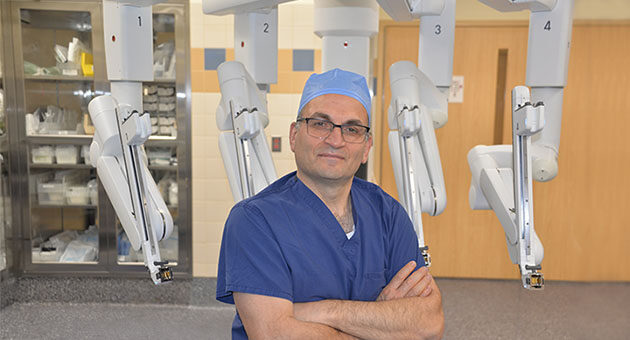Robotic Technique Offers Enhanced Option for Kidney Donors

Albany Medical Center’s Kidney Transplant Program has begun offering robotic nephrectomy as a less invasive option for kidney donation and transplantation, improving the experience for living kidney donors.
Robotic nephrectomy is the removal of a kidney using the da Vinci robotic surgical system. The arms of the robotic instrument are inserted through small incisions, similar to laparoscopic surgery, and controlled by the surgeon from a console. In a living donor nephrectomy, a healthy kidney is removed from one individual and transplanted into the patient in need of a new kidney. These procedures traditionally have been performed laparoscopically or in open (traditional) surgeries.
“The robotic technique provides a three-dimensional view and smaller, more flexible instruments in which to remove the kidney, often leading to a quicker recovery for the patient with less pain and scarring than a traditional surgery,” said Rauf Shahbazov, MD, chief of the division of Transplant Surgery at Albany Medical Center and robotic surgeon. “Our Kidney Transplant Program has a reputation for providing high quality, compassionate care to patients throughout our region and we’re proud to offer this latest technique to enhance care even further.”
John Church, 60, of Delmar, who donated a kidney to his longtime friend Stephen Smith, 64, of East Greenbush earlier this year, was one of the first patients to undergo the surgery using the new technique.
“I was committed to donating my kidney to Stephen either way, but I was happy to hear that there was a much less invasive procedure with a better chance of success,” Church recalled. “They said recovery would be four to six weeks and they were pretty spot on. I was very well prepared by the transplant team and would encourage anyone to consider donating if they are able to.”
Because more than 90,000 people are on the kidney transplant waiting list in the United States, some people choose to be tested to determine if they are a match for a friend, loved one, or in some cases a stranger. Living donors go through a series of evaluations to determine their suitability to donate.
“The impact of robotic surgery on donors is great. We hope that with minimized pain and a faster recovery, more people will consider living donation,” said Dr. Shahbazov.
Albany Medical Center’s Robotic Surgery program, instituted in 2003, has served tens of thousands of patients for procedures in cardiac, general, gynecological, urological, otolaryngology (ENT), thoracic, pulmonary, hepatobiliary, bariatric, pediatric, and now transplant surgery.